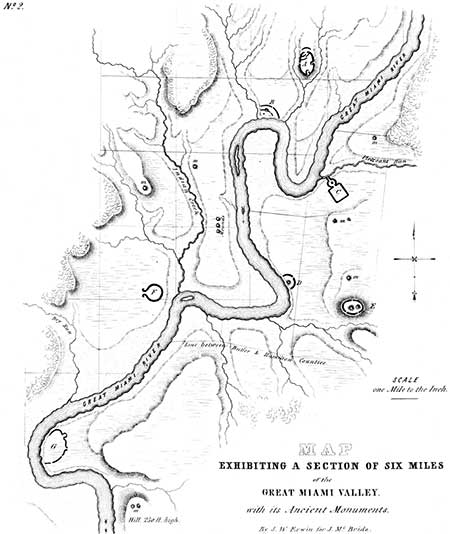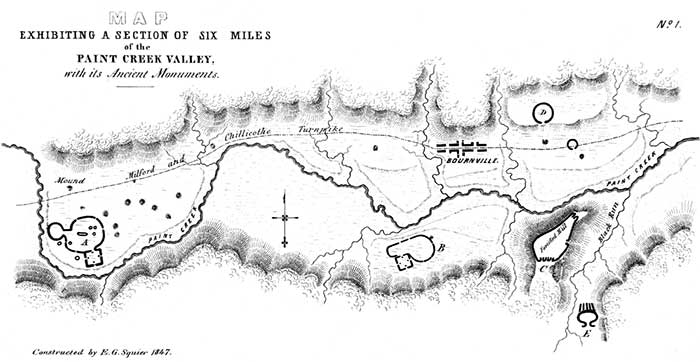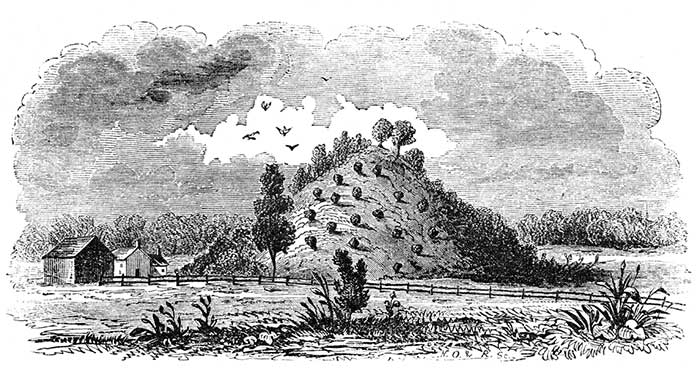PLATE III, No. 1. Valley of Paint Creek.
PLATE III, No. 1, exhibits a section of six miles of the Valley of Paint Creek, a tributary of the Scioto river. The village of Bourneville is ten miles west of Chillicothe. Within this limit are embraced three works of extraordinary size, besides several smaller ones. The works, designated by the letters A and B, have each upwards of two miles of heavy embankment, and contain not far from one hundred acres. The stone work C has an area of one hundred and forty acres, enclosed within a wall upwards of two and a fourth miles long. Enlarged plans of the various works here indicated are given in the following pages. A and B, Plate XXI; C, Plate IV; D and E, Plate XXX.
PLATE III, No. 2. The Great Miami Valley.
 PLATE III, No. 2, presents a section of six miles of the Great Miami valley,
included principally within the limits of Butler county, Ohio. Not less than seven
enclosures, of considerable size, occur within these bounds. The work indicated
by the letter G contains ninety-five acres. An enlarged plan of' the work marked
A, is given on Plate VI; of
B, on Plate XI;
C and F, on Plate XXX;
D, Plate XXXI; and
G, on Plate XIII.
PLATE III, No. 2, presents a section of six miles of the Great Miami valley,
included principally within the limits of Butler county, Ohio. Not less than seven
enclosures, of considerable size, occur within these bounds. The work indicated
by the letter G contains ninety-five acres. An enlarged plan of' the work marked
A, is given on Plate VI; of
B, on Plate XI;
C and F, on Plate XXX;
D, Plate XXXI; and
G, on Plate XIII.
Not far from one hundred enclosures of various sizes, and five hundred mounds, are found in Ross county, Ohio. The number of tumuli in the State may be safely estimated at ten thousand, and the number of enclosures at one thousand or fifteen hundred. Many of them are small, but cannot be omitted in an enumeration. They are scarcely less numerous on the Kenhawas in Virginia, than on the Scioto and Miamis; and are abundant on the White river and Wabash, as also upon the Kentucky, Cumberland, Tennessee, and the numerous other tributaries of the Ohio and Mississippi.
Nor is their magnitude less a matter of remark than their great number. Lines of embankment, varying in height from five to thirty feet, and enclosing areas of from one to fifty acres, are common; while enclosures of one or two hundred acres area are far from infrequent. Occasional works are found enclosing as many as four hundred acres3 The magnitude of the area enclosed is not, however, always a correct index of the amount of labor expended in the erection of these works. A fortified hill in Highland county, Ohio, has one mile and five-eighths of heavy embankment; yet it encloses an area of only about forty acres. A similar work on the Little Miami river, in Warren county, Ohio, has upwards of four miles of embankment, yet encloses little more than one hundred acres. The group of works at the mouth of the Scioto river has an aggregate of at least twenty miles of embankment; yet the entire amount of land embraced within the walls does not probably much exceed two hundred acres.
The mounds are of all dimensions, from those of but a few feet in height and a few yards in diameter, to those which, like the celebrated structure at the mouth of Grave Creek in Virginia, rise to the height of seventy feet, and measure one thousand feet in circumference at the base. The great mound in the vicinity of Miamisburgh, Montgomery county, Ohio, is sixty-eight feet in perpendicular height, and eight hundred and fifty-two in circumference at the base, containing 311,353 cubic feet.
The truncated pyramid at Cahokia, Illinois, has an altitude of ninety feet, and is upwards of two thousand feet in circumference at the base. It has a level summit of several acres area. The great mound at Selserstown, Mississippi, is computed to cover six acres of ground. Mounds of these extraordinary dimensions are most common at the south, though there are some of great size at the north. The usual dimensions are, however, considerably less than in the examples here given. The greater number range from six to thirty feet in perpendicular height, by forty to one hundred feet diameter at the base.5
All the above-mentioned constructions are composed of earth or stone; though a combination of these materials in the same work is by no means rare. When there are no ditches interior or exterior to the embankments, pits or "dug holes," from which the earth for their formation was taken, are generally visible near by. These are sometimes very broad and deep, and occasionally quite symmetrical in shape.6 In the vicinity of large mounds such excavations are common. The earth and stone composing these works are sometimes foreign to the locality which they occupy, and must have been brought from considerable distances.
A large, perhaps the larger, portion of these enclosures are regular in outline, the square and the circle predominating. Some are parallelograms, some ellipses, others polygons, regular or irregular. The regular works are almost invariably erected on level river-terraces, great care having evidently been taken to select those least broken. The irregular works are those which partake most of the character of defences, and are usually made to conform to the nature of the ground upon which they are situated, running along the brows of hills, or cutting off the approaches to strong natural positions. The square and the circle often occur in combination, frequently communicating with each other or with irregular works directly, or by avenues consisting of parallel lines of embankment. Detached parallels are numerous. The mounds are usually simple cones in form; but they are sometimes truncated, and occasionally terraced, with graded or winding ascents to their summits. Some are elliptical, others pear-shaped, and others squares or parallelograms, with flanking terraces. Besides these, there are others already alluded to, most common in the extreme north-west,which assume the forms of animals and reptiles. Another variety of remains are the causeways or "roads," and the graded descents to rivers and streams, or from one terrace to another. These several classes of works will be described at length, under appropriate heads.
As already remarked, these remains occur mainly in the valleys of the Western rivers and streams. The alluvial terraces, or "river-bottoms," as they are popularly termed, were the favorite sites of the builders. . The principal monuments are found where these "bottoms" are most extended, and where the soil is most fertile and easy of cultivation. At the junction of streams, where the valleys are usually broadest and most favorable for their erection, some of the largest and most singular remains are found. The works at Marietta; at the junction of the Muskingum with the Ohio; at the mouth of Grave Creek; at Portsmouth, the mouth of the Scioto; and at the mouth of the Great Miami, are instances in point. Occasional works are found on the hill tops, overlooking the valleys, or at a little distance from them; but these are manifestly, in most instances, works of defence or last resort, or in some way connected with warlike purposes. And it is worthy of remark, that the sites selected for settlements, towns, and cities, by the invading Europeans, are often those which were the especial favorites of the mound-builders, and the seats of their heaviest population. Marietta, Newark, Portsmouth, Chillicothe, Circleville, and Cincinnati, in Ohio; Frankfort in Kentucky; and St. Louis in Missouri, may be mentioned in confirmation of this remark. The centres of population are now, Where they were at the period when the mysterious race of the mounds flourished.7
The aboriginal monuments of the Mississippi valley, the general character of which has been thus briefly and imperfectly indicated, fall Within two general divisions, namely, CONSTRUCTIONS OF EARTH OR STONE, comprising Enclosures, Mounds, etc.; and MINOR VESTIGES OF ART, including the Implements, Ornaments, Sculptures, etc. of the ancient people.
The Earth and Stone Works resolve themselves into two classes, viz: ENCLOSURES, bounded by embankments, circumvallations, or walls; and simple tumuli, or MOUNDS.8 They constitute, together, a single system of Works; but, for reasons which will satisfactorily appear, it is preferred to classify them as above. These grand classes resolve themselves into other subordinate divisions: ENCLOSURES FOR DEFENCE, SACRED AND MISCELLANEOUS ENCLOSURES; MOUNDS or SACRIFICE, TEMPLE MOUNDS, MOUNDS OF SEPULTURE, etc.
3. Lewis and Clarke describe one on the Missouri river which they estimated to contain not far from six hundred acres.—Travels, p. 47.
4. From a sketch by Henry Howe, Esq.
5. "We have seen mounds which would require the labor of a thousand men employed upon our canals, with all their mechanical aids, and the improved implements of their labor, for months. We have more than once hesitated, in view of one of these prodigious mounds, whether it were not really a natural hill. But they are uniformly so placed, in reference to the adjacent country, and their conformation is so unique and similar, that no eye hesitates long in referring them to the class of artificial erections."—Flint's Geography, p. l3.
6. These are the "wells" of Mr. Atwater and other writers on American antiquities. It is barelv possible that a few were really wells, or secondarily designed for reservoirs.
7. "The most dense ancient population existed in precisely the places where the most crowded future population will exist in ages to come. The appearance of a series of mounds generally indicates the contiguity of rich and level lands, easy communications, fish, game, and the most favorable adjacent positions."—Flint.
"The most numerous, as well as the most considerable of these remains are found precisely in any part of the country where the traces of a numerous population might be looked for."—Brackenridge.
8. The term Mound is used in this work in a technical sense, as synonymous. with Tumulus or Barrow, and in contradistinction to embankment, wall, &c.



